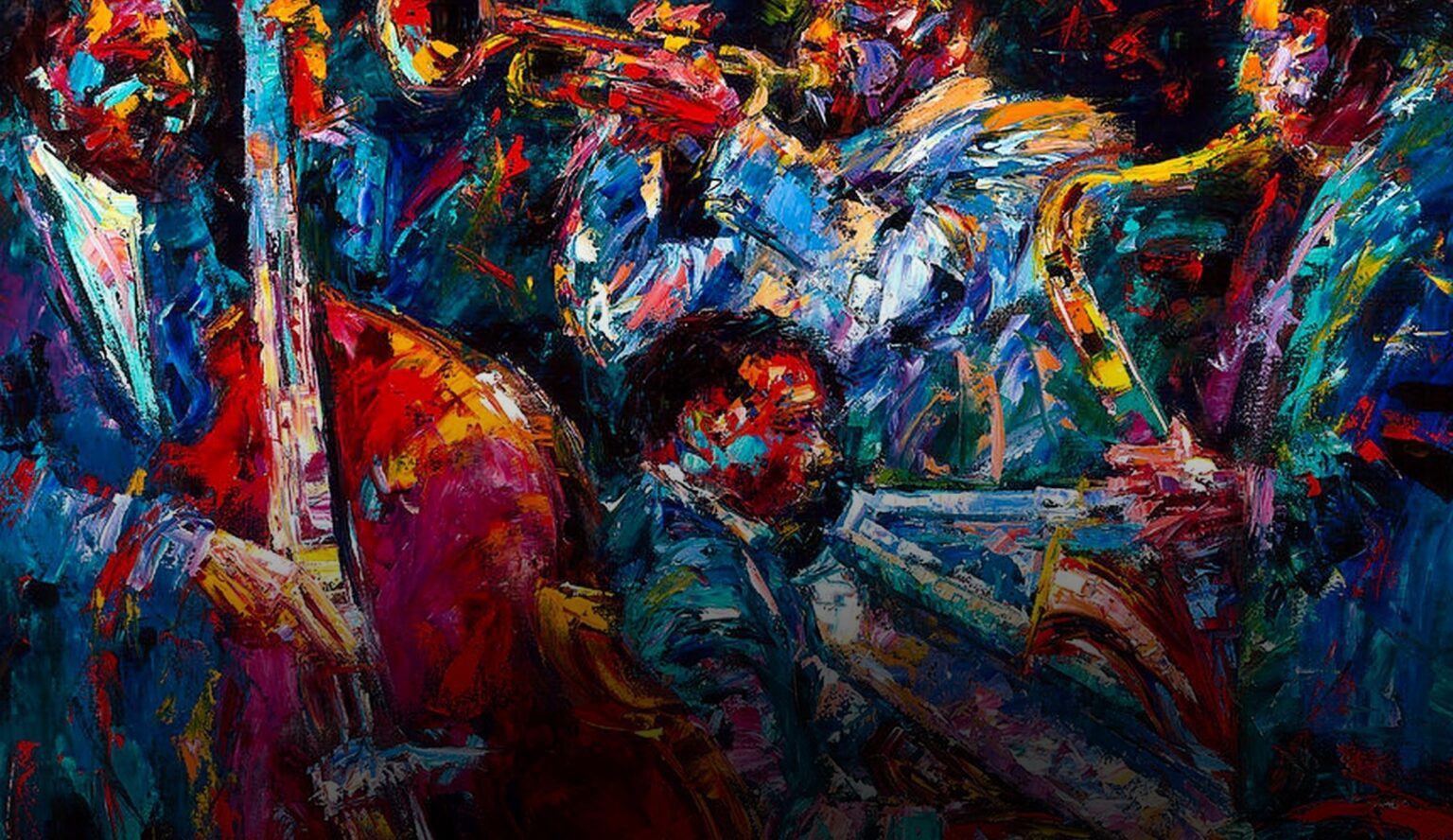Artwork: Debra Hurd
This article is the written script of an episode from our podcast series: Kandelaa – Conversations.
( Bu yazı, podcast serimiz Kandelaa – Conversations’tan alınan bir bölümün yazılı metnidir. )
“Jazz is not just music. It’s a way of life; it’s a way of being, a way of thinking.” says Nina Simone; and Art Blakely also adds “Music washes away the dust of every life.” Be ready to have a look at the jazz music, after which you hopefully release yourself to a record and feel your veins fill up with the colorful waves of energy. Today, jazz is what we talk about.
Jazz is a musical genre that started to become even more popular during the 20th century. Scattered from the African communities in New Orléans and Louisiana, jazz spread across the world over time. The most outstanding characteristics of jazz music are complicated chords, improvisations, swing, and polyrhythms.
Where jazz got its name from was documented rather well- it’s most likely a name derived from the slang word jasm, meaning energy, vitality, and pep. One other recollection that supports this view was of the famous performer Eubie Blake: “When Broadway picked it up, they called it ‘J-A-Z-Z’. It wasn’t called that. It was spelled ‘J-A-S-S’. That was dirty, and if you knew what it was, you wouldn’t say it in front of ladies.” The American Dialect Society named it the Word of the 20th Century. (Wikipedia)
Defining jazz is particularly hard because the music we deal with constantly evolved and altered through time.; even any two subgenres of different phases of jazz, like the New Orléans style and the free jazz, can potentially show contrasts. Jazz is a musical medley that was mainly rooted in the African music culture but still blended with the style of European music in North America.
During the plantation, hundred of thousands of African slaves were brought to North American soil. These people kept maintaining their musical culture alive, but it was occasionally constrained in certain ways: The Black Codes, laws intervening with black conduct, had once forbidden drumming among black people. The rhythmic motifs remained as body-engaged styles, such as clapping, in the United States.
Perhaps not in North America, yet by the dislike growth against jazz, the genre was banned in the Soviet Union since it was seen as threatening to cultural integration. Distinctively, the African tribe music didn’t contain polyphonic elements and instead concentrated on a monophonic style. After a while, African performers would be introduced to the European instruments that comprised an important part of the military orchestras. Several wind instruments were trombone, trumpet, and possibly tuba. Moreover, the harmonic patterns, which were considerably taken from the church hymns, began to ingrain into the African music style.
As we mentioned earlier, jazz has an attractively unique mixture of different cultural elements. Defining jazz is a hard job, but still, one accepted characteristic of this musical genre is a strong improvisation style. Also, let’s note once again that the styles within jazz could be incompatible with each other according to their eras, so by mentioning improvisations, we should acknowledge the differences seen in this technique through periods. In the Orléans (Dixieland) style, musicians apply the technique mostly by squabbles. The attention that these performers play their melodies in turn, but in the classical style, one certain melody is taken as reference.
Come to mention the contributors of jazz, Ragtime was one of those which highly depends on syncopated rhythm. One definition for ragtime is: The rag was a modification of the march made popular by John Philip Sousa, with additional polyrhythms coming from African music. ] It was usually written in 2/4 or 4/4 time with a predominant left-hand pattern of bass notes on strong beats (beats 1 and 3) and chords on weak beats (beats 2 and 4) accompanying a syncopated melody in the right hand. (citation from Wikipedia).
Tony Jackson, Louis Chauvin, and Scott Joplin were among the successful ragtime musicians. Especially Joplin saw ragtime as “a permanent” musical genre and was known for his classical works including études and even operas.
Blues, in my opinion, can be the subgenre and another forerunner of jazz that reflected the African roots at the utmost degree. African slaves, who were brought to North America, used to preserve their musical spirit through their songs and spirituals. Sung during labor, Blues kreflected the hopes, grief, agony, and desire for freedom of the African people. Later on, blues would be mixed with new patterns as well.
Among the successful jazz performers were Miles Davis, John Coltrane, Keith Jarrett, Mary Lou Williams, Duke Ellington, Herbie Hancock, Wynton Marsalis, and many more.
Women had a remarkable role in the jazz world; even though the female performers weren’t as many as men in the field. Instrumental performance should, in fact, be given credit alongside spectacular vocals such as Ella Fitzgerald, Billie Holiday, Ethel Waters, and more. Being the first major woman instrumental in jazz, Louis Armstrong’s wife Lil Hardin was a significant pianist who also took place in several bands. However, the professional jazz environment has been not much benign and encouraging to women as it was to men. Apart from the female musicians we know, women didn’t readily receive support all the time.
Jazz is a colorful and worthy culture to live in. Various elements combined to ferment all together, which gifted us listeners one different color from each era of jazz. Now, it’s a splendid medley! With its unique atmosphere, capturing rhythm, vital melodies, and originality, liking jazz is easier than falling off a log.

